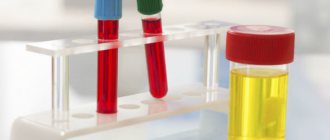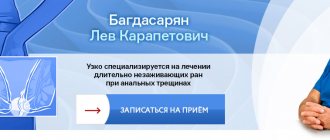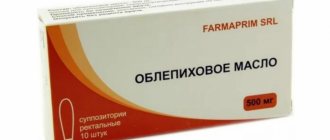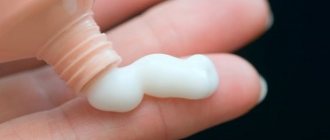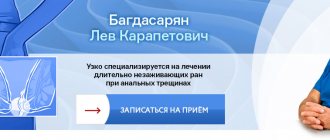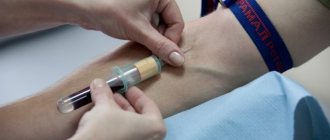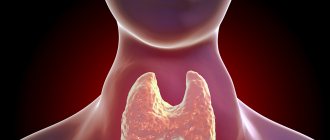Attention!
The information in the article is for reference only and cannot be used for self-diagnosis or self-medication. If you notice any symptoms of the disease, contact your doctor.
- Suppositories for hemorrhoids
- Ointment for hemorrhoids
- Tablets for hemorrhoids
- Surgery to remove hemorrhoids
Hemorrhoids are varicose veins of the rectum and anus. Dilated veins are deformed with the formation of hemorrhoids, their walls become thinner and become easily vulnerable. Hemorrhoids can be either an independent disease or a manifestation of another pathology, for example, cirrhosis of the liver.
Types of hemorrhoids
There are three types of pathology - external, internal and mixed hemorrhoids.
Interior
Internal hemorrhoids are considered to be the presence of varicose veins inside the ampulla. Nodes are formed inside on its walls. The formations lie in the thickness of the mucous ampulla of the rectum, located above the dentate zone. Here is the internal venous plexus.
The inner ties are quite treacherous. They do not show themselves in anything for a long time. Small lumps remain asymptomatically inside the intestine for a long time. Only later, when the process decompensates, do clinical manifestations become obvious - discomfort, burning in the anal area, swelling in this area, painful bowel movements, blood on toilet paper.
Outer
External hemorrhoids are a pathology that forms when blood circulation in the anal venous network is impaired. Vasodilation occurs in certain areas of the vessels - cavernous bodies, followed by the formation of nodes. They are located directly under the skin in the area below the rectal-anal line.
There are common and complicated forms of the disease. With it, hemorrhoids bleed, fall out, become pinched and ulcerate. This type of damage to the venous vessels in the anal area manifests itself with striking clinical manifestations. External hemorrhoids almost immediately after their appearance introduce discomfort into the patient’s usual lifestyle.
The patient is concerned about pain in the anal area and itching. They appear first during bowel movement, and then are present constantly. Symptoms intensify with physical activity, sneezing, and sitting for long periods of time.
Hemorrhoids in women
Contrary to popular belief that men are more likely to suffer from hemorrhoids, they often occur in women as well. Predisposition to the disease is inherited, and its occurrence is also determined by the patient’s lifestyle. In patients it often occurs for the following reasons:
- constipation;
- passive lifestyle;
- pregnancy;
- as a complication during childbirth;
- due to vascular pathologies.
Hemorrhoids in women occur due to pathologies in the pelvic cavity, digestive disorders and tumors.
Changing our lifestyle
Since one of the causes of hemorrhoids is poor blood circulation in the vessels, which is facilitated by a sedentary lifestyle, this habit needs to be completely changed. If you don’t have the time or desire to exercise, then just start walking. Walk every day, if possible, walk to and from work. Add here a daily routine of simple exercises, and you will greatly reduce the risk of hemorrhoids.
Important! If there are initial signs of hemorrhoids, then lifting weights in the gym is contraindicated!
Hemorrhoids in men
Hemorrhoids occur slightly more often in men than in women. The reason for this is the lack of attention on the part of the stronger sex to their health. They see a doctor in the later stages of the disease. The causes of hemorrhoids in men are as follows:
- work with a predominance of heavy physical labor, heavy lifting;
- sedentary work;
- presence of bad habits: alcohol abuse, smoking;
- nutritional obesity;
- neglecting the need to regularly empty the intestines;
- prolongation of the act of defecation;
- chronic stress.
The causes of secondary hemorrhoids are somatic diseases: oncological processes, portal hypertension, heart failure.
Benefits of Duphalac®
- Duphalac® has a favorable safety profile6,7.
- The drug can be used for as long as necessary5,7, which is suitable for people with hemorrhoids, since in most cases it is a chronic problem.
- Duphalac® is approved for use by pregnant women, who may also experience this problem. You can read more about this in the material “Hemorrhoids during pregnancy.”
The material was developed with the support of Abbott to improve patient health awareness. The information in the material does not replace the advice of a healthcare professional. See your doctor.
RUS2120920 from 03/25/2020 Your browser does not support the video tag.
Co-author of articles, editor - Shimbaretsky Georgy Alekseevich.
Stages of hemorrhoids
Hemorrhoids go through several stages in their development. They are characterized by the following manifestations:
- First. At this stage, moderate bleeding from hemorrhoids in the anus is detected. The patient notices it after defecation on toilet paper. At other times there is practically no bleeding. Sometimes bowel movements are accompanied by shooting pain. In the external form, a small formation appears located at the anus. It's painful. With the internal version of the disease, minor bleeding is observed.
- Second. At this degree, a more pronounced clinical picture appears with a characteristic symptomatic complex. The venous nodes are already protruding, but they are also retracted into the rectum on their own. This process is accompanied by a slight release of blood. Among the typical clinical manifestations, prolapse of hemorrhoids is noted. Blood is released after defecation or at rest. There is mucus discharge from the anus, burning, peeling around the anus and itching. Nodes may fall out. This occurs after significant physical activity, with constipation and sudden movements.
- Third. At this stage, nodes fall out. They can no longer retract on their own. To reduce the formations, a special procedure must be performed. You can perform manual reduction yourself. When the prolapse occurs, bleeding begins. It occurs after intense physical exertion. The patient has bleeding both at rest and after bowel movement. He experiences itching and flaking of the skin near the anus. Often the situation is complicated by the formation of anal fissures, wounds, and sphincter incontinence. The patient experiences constant discomfort, as well as paroxysmal shooting pains. Mucus mixed with blood is often released from the anus. A small amount of it indicates thinning of the walls of the node. A large amount of blood indicates that the blood clot has spread beyond the node.
- Fourth. This stage significantly reduces the quality of life. The nodes fall out and cannot be adjusted either manually or using special procedures for reduction. The patient constantly leaks blood from the nodes. Bleeding increases after defecation. The patient experiences discomfort due to rectal sphincter incontinence. The patient periodically experiences acute pain. Numerous wounds and cracks around the anus are revealed. He constantly scratches this area, and a secondary infection develops. Formed blood clots can break off at any time and block blood flow through the pelvic vessels.
The patient’s treatment tactics depend on the identified stage of hemorrhoids. In the initial stages of the disease, conservative therapy is used. In the later stages of the inflammatory process, surgical techniques are used for treatment.
Diagnosis of hemorrhoids
Diagnosis of this disease is not difficult. It is performed by a proctologist or surgeon. The doctor interviews the patient, finds out his complaints and information about the course of the disease. Then carries out the following activities:
- Inspection. They examine patients in a chair. To do this, bring your knees as close to your stomach as possible. If there is no chair, the examination is carried out in the knee-elbow position. The doctor examines the anus area. Reveals his anal deformation. He evaluates the skin around it and examines the hemorrhoids.
- Finger examination. The condition of the external and internal sphincters, as well as the mucous membrane, is studied. The doctor determines the location and size of hemorrhoids. He evaluates the possibility of their reduction.
- Anoscopy. This endoscopic method allows you to examine up to 12 cm of the anal canal. Patients easily tolerate this procedure. With its help, the location of internal nodes is determined.
- Sigmoidoscopy. It is prescribed to exclude pathology of the upper intestines.
If it is necessary to identify complications and concomitant pathologies, the patient is referred to other types of examination - ultrasound of the abdominal cavity and gastroscopy.
Treatment of hemorrhoids
Treatment of this pathology is determined by the stage of the disease, the presence of complications and the general condition of the patient.
Suppositories for hemorrhoids
Suppositories are quite effective in treating the initial stage of internal hemorrhoids. They are used as the main method of therapy. They have the following advantages:
- the drug is applied topically to damaged vessels and tissues, and is not absorbed into the general bloodstream;
- quickly remove pathological manifestations;
- no side effects;
- they are convenient to use;
- they have a minimum of contraindications.
In the later stages of the process, rectal suppositories are used as concomitant therapy for rehabilitation and follow-up treatment. Suppositories for hemorrhoids are divided according to the effect they have on the body:
- Painkillers. Pain relievers are present in suppositories for hemorrhoids.
- Anti-inflammatory. These drugs are used when there is inflammation in the nodes and nearby tissues. They reduce the activity of the rectal mucosa and in dilated veins.
- Anticoagulants. Medicines containing these substances reduce blood clots. They stop the coagulation of venous blood.
- Hemostatic. For bleeding from nodes, suppositories with hemostatic agents are used.
- Immunomodulators. They normalize local immunity and increase tissue resistance to infection.
Their action is aimed at relieving exacerbations and slowing down the progression of hemorrhoids.
Ointment for hemorrhoids
The drugs are used for external and internal hemorrhoids. The package contains special nozzles for administering the medicine into the rectum. They contain the following substances:
- anticoagulants;
- venotonics;
- hemostatics;
- anti-inflammatory;
- immunomodulators;
- hormonal;
- astringents;
- antiseptics.
Ointments are used in the early stages of nodule formation. They remove the main symptoms that bother the patient at this stage - irritation of the skin and mucous membranes, itching and burning.
Tablets for hemorrhoids
For the treatment of the disease, the main tablet drugs are considered to be drugs from the group of venotonics and angioprotectors. They strengthen the vascular wall, prevent the progression of hemorrhoids, and increase the tone of the veins. For persistent severe pain, patients are prescribed painkillers.
Surgery to remove hemorrhoids
To excise hemorrhoids, classical and minimally invasive surgical techniques are now used in surgery. They are carried out at the third and fourth stages of the pathological process. The following minimally invasive interventions are used:
- disarterization - ligation of the arteries supplying the node;
- latex ligation - excludes hemorrhoidal formation from the bloodstream by placing a latex ring on its base;
- sclerotherapy - a special preparation is injected into the node, gluing its walls;
- laser coagulation – the laser coagulates the entire venous formation;
- cryodestruction - the node is frozen with liquid nitrogen.
Classic surgery is now used only if a minor intervention does not achieve the desired result.
Principles of prevention
1. Normal physical activity
. Let's use the principle of reasonable sufficiency. The body requires regular moderate exercise to function naturally. One simple exercise can be walking or swimming. During the day, short breaks for exercise or regular walking will help restore normal blood circulation. And when doing fitness, you need to comply with the permissible load for your age, weight and health status.
2. Diet
. Normalize the daily diet in composition and quantity and consume enough liquid. Excessively salty, hot, spicy foods should be avoided. It is necessary to give up sugary carbonated drinks, alcohol consumption, and excessive coffee consumption. For constipation, you need to increase the content of fermented milk and fiber-containing products, reduce fatty and protein foods.
If the problem has already appeared, then local drugs with an analgesic, anti-inflammatory and healing effect (suppositories, creams) can be used to treat it, as well as laxatives to soften the contents of the intestines, and hence reduce pain when going to the toilet3,4 .
For hemorrhoids, regardless of the presence or absence of constipation, Duphalac®5 may be the optimal choice. The drug has a double effect.
Firstly, by attracting water into the intestines, Duphalac® softens the stool, providing a gentle and comfortable cleansing of the intestines. This may help reduce pain and discomfort when going to the toilet. The second effect of Duphalac® is to normalize the intestinal microflora due to the prebiotic effect.



